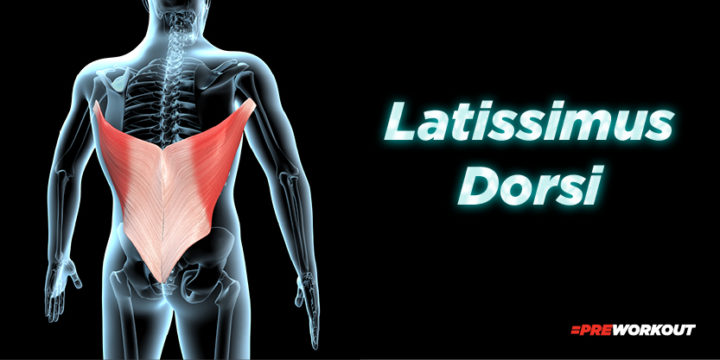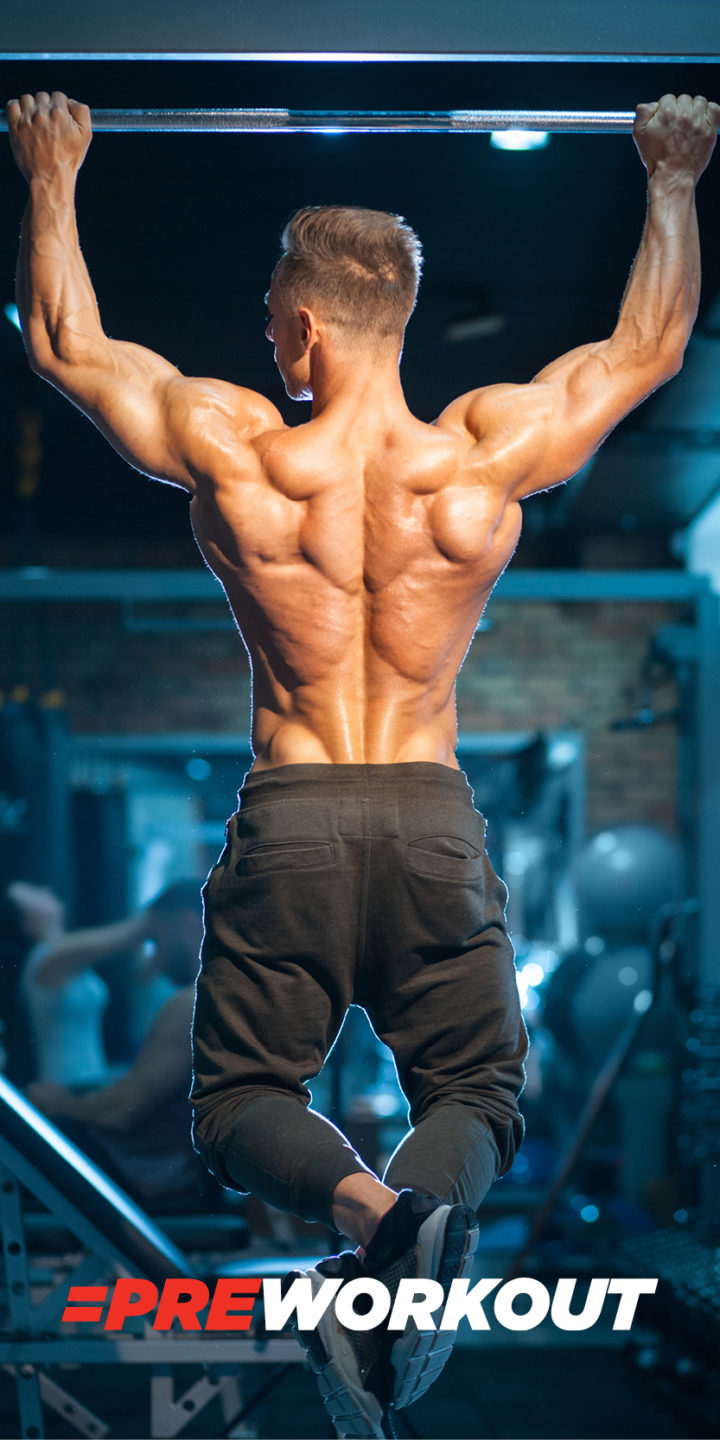(WITH 3 GREAT LAT WORKOUTS)
Although you can’t see your lats in the mirror, a big back and wide lats are something most lifters aspire to have. Well-developed lats give you an impressive v-taper and are critical for total body strength. As most elite lifters will tell you, lifting big weights with powerful lats is a lot easier.
The problem is, most people spend too much time on the wrong lat exercises. You don’t need to reinvent the wheel. The basics are highly effective. Read on to find out the best lat exercises, why they work, and how to put together killer lat workouts. We also suggest you read the best pre-workout ingredients for strength and power.
In this article, we will also cover the following:
- How the lats work and what they do in the body
- Best dumbbell, barbell, and cable lat exercises
- Three killer lat workouts
- How to progressively overload the lats
- Best supplements for lat growth and recovery
How The Lats Work and What They Do In The Body

The back musculature consists of four main muscle groups – the latissimus dorsi, rhomboids (major and minor), trapezius, and spinal erectors. The latissimus dorsi, or lats for short, make up the bulk of the back and contribute the most to the appearance of width. You have two of them, one on each side. They are large fan-shaped muscles that start at the spine and wrap around the torso.
The lats have two main functions, shoulder adduction and extension. Shoulder adduction involves pulling your upper arms from out at your sides closer to the torso. And shoulder extension is moving the arms from out in front of the body closer to the torso. To maximize lat development, we want to train both movement patterns. The best way to do that is through vertical and horizontal pulls.
Generally, when people think of lat training, lat pulldowns and pullups immediately come to mind. And for a good reason. Research shows both lat pulldowns and pullups are excellent exercises for training the lats [1,2].
However, if you only do vertical pulling exercises, you will miss out on potential growth. It’s a common misconception that rows don’t build the lats.
A 2004 study comparing muscle activity during pulldowns and rows found horizontal rowing exercises have the same lat activity as pulldowns [3]. Additionally, rows train the lower trapezius and rhomboids more effectively than pulldowns.
Best Lat Exercises With Dumbbells
Here are the two best dumbbell lat exercises. Including dumbbells in your lat training is essential because they train each lat individually, preventing (or correcting) muscle or strength imbalances.
Incline Prone Dumbbell Chest Supported Row
The seal row gets all the attention, and for a good reason. However, if your gym doesn’t have a specific seal row bench, the setup time is too long for many people. The incline dumbbell chest-supported row is an excellent alternative.
Although not entirely the same as a seal row, it offers many similar benefits. For one, the chest support takes the pressure off your lower back. Secondly, leaning into the chest support makes it hard to cheat. Many people struggle to maintain strict form with back training. The chest support takes out the ability to use momentum to lift the weight up.
One Arm Dumbbell Row
The old-school dumbbell row is one of the best exercises to build upper back and lat strength. It’s a unilateral exercise, which works individually on each side of the lats, preventing muscle imbalances. Also, because of the unilateral nature of the movement, we can brace the upper body with one hand while rowing with the other. Being able to brace takes some of the pressure off the lower back.
Remember, there is no trophy handed out to the strongest dumbbell rower. Use a weight you can handle with good technique and a full range of motion.
Best Bodyweight Lat Exercises
Bodyweight exercises are an excellent option when you have limited equipment, but pullups and inverted rows should also be a part of your regular gym routine.
Pullup
If I had to pick only one lat building exercise for the rest of my life, I would choose the pullup. Depending on your strength level, they are an excellent choice with just your body weight, added weight via a belt or vest, or assistance.
The most significant mistake people make with pullups is cutting the rep short. It can happen both at the bottom and the top of the repetition. Make sure you pull yourself all the way up so that your chin gets above the bar. At the bottom, each rep needs to start with your arms fully locked out.
Inverted Row
Inverted rows are among the most underrated exercises to build upper-back and lat strength. They offer a unique alternative to traditional barbells, dumbbells, and cable movements.
The key is maintaining tension in the core and glutes. Which keeps the body straight during the movement without letting the hips sag.
Interestingly, research comparing different rowing variations found the inverted row elicited higher lat activation than the standing bent-over row and standing one-armed cable row [4]. Throw these in toward the end of your lat workout for the best results.
Best Barbell Lat Exercises
An article on best exercises would only be complete by including a couple of barbell movements. Deadlifts and barbell rows are hard to beat regarding back training.
Deadlift
The deadlift is one of the few foundational exercises. Some fitness professionals may even say the deadlift is the most effective all-around exercise to build muscle and strength. It trains the entire posterior chain – lats, rhomboids, traps, erectors, hamstrings, and glutes. Plus, it is highly functional. The act of picking things up off the ground is something we all do daily. Spending a lot of time on the deadlift platform makes sense if you want to be big and strong.
Barbell Row
There is no denying the benefits of the barbell row. It’s one of the staple back-building movements, primarily because you can handle more weight on a barbell row than any other row variation.
That said, people often need to improve their technique on the barbell row. Our goal with this exercise is to use it to build muscle in the upper back and lat region, not to see how much weight we can throw around with sloppy form. During the movement, keep the torso ridged and the knees slightly bent. Don’t allow the back or knee angle to change as you row the barbell up.
Best Cable Machine Lat Exercises
The best aspect of cable exercises for back training is the constant tension. Yes, barbells and dumbbells are great but don’t sleep on cable exercises.
Lat Pulldown
It doesn’t matter what type of gym you train at; you will most likely have access to a lat pulldown machine. And, as the name suggests, the lat pulldown is an excellent lat exercise.
A big mistake people need to correct in this movement is leaning too far back. Try to avoid turning this into a row. When leaning back, it shifts focus away from the lats onto the upper back muscles. Aim to maintain a vertical torso.
Research shows bringing the bar down to the front of the body is slightly better when compared to pulling behind the head [5]. Plus, lat pulldowns to the front allow for greater loads and are safer on shoulders.
Rope Lat Extensions
One of the significant benefits of this exercise is the biceps aren’t involved as much as in pulldowns or rows, which can be helpful if you have trouble “feeling” your back work. Additionally, the lat extension puts a good stretch on the lats in the starting position.
Although lat extensions and triceps pressdowns look very similar at a distance, arm angle is the critical difference. On lat extensions, it’s imperative not to change your elbow angle during the lift. You may still feel it in your triceps, but less if you allow your elbow to bend during the movement.
Once you get into the correct position, lock your arm nearly straight and keep it in that position for the duration of the set.
Killer Lat Workout 1
- Barbell Deadlift: 5 sets x 3-5 reps
- Pullups: 50 reps in as few sets as possible.
- Dumbbell Row: 4 sets x 8-10 reps
- Rope Lat Extensions: 3 sets x 10-12 reps
Killer Lat Workout 2
- Barbell Row: 4 x 6-8 reps
- Lat Pulldown: 4 sets x 8-10 reps
- Incline Prone Dumbbell Chest Supported Row: 3 sets x 8-10 reps
- Inverted Row: 50 reps in as few sets as possible.
Killer Lat Workout 3
- Barbell Deadlift: 3 sets x 6-8 reps
- Pullups: 4 sets x 6-8 reps
- Incline Prone Dumbbell Chest Supported Row: 4 sets x 8-10 reps
- Lat Pulldown: 3 sets x 10-12 reps
How To Progressively Overload the Lats for Hypertrophy
When training for hypertrophy, we know the workouts must be progressive to be effective. The phrase progressive overload gets thrown around a lot, but it is simply the gradual increase of stress placed upon the muscle. There are many ways to build progressive overload into a training plan to develop big lats.
Here are a few:
- Linear load increases: Add more weight to the exercise over time while keeping reps and sets the same.
- Linear rep increases: Add a repetition or two over time while keeping the weight and sets the same.
- Linear set increases: Add a set or two to the exercise over time while keeping the weight and reps the same.
One recommendation to help you progress your lat training is to keep a notebook to jot down sets, reps, and weights. It helps you stay organized and gives you concrete numbers to aim to beat.
Best Supplements For Lat Muscle Growth and Recovery
Here are three supplements to help build a barn door back.
Protein Powder: Building big lats requires more effort than lifting heavy weights. What you do in the kitchen is just as important. A high-quality protein powder offers a convenient way to help you meet your daily protein requirements. Protein supplements have advanced a lot in recent years. Most protein powders today taste great, and you have many different options. Whey concentrate, whey isolate, milk protein isolate, casein, and vegan blends with pea or hemp protein.
Current research supports the standard recommendation of one gram of protein per pound of body weight [6]. Consume one to two protein shakes daily, depending on your daily protein needs.
Creatine: Creatine has been one of the most studied sports supplements over the past two decades. It’s tried and true. There are many variations, but creatine monohydrate is still the most affordable and effective [7]. Take 3 to 5 grams of creatine monohydrate daily.
Caffeine: Caffeine is well known for getting you up in the morning, but it has also been shown to improve strength and muscular endurance in the gym [8]. Consume 200 to 400 milligrams about 30 minutes before exercising.
Frequently Asked Questions about Lat Excercises
What’s the best lat exercise for increasing lat mass?
The best exercise for increasing lat mass is a toss-up between pullups and barbell rows.
What’s the best lat exercise for increasing width?
The best exercise to increase lat width is lat pulldowns or pullups.
Which lat exercises can I do at home with no equipment?
Pullups and inverted rows are great lat exercises you can do at home without equipment. Find something to hang off from if you don’t have a pullup bar. You can do inverted rows on the edge of a table with your feet hanging underneath.
Can I gain lat strength without bulking up and gaining mass?
You can gain lat strength without bulking up and gaining mass. The key is to focus on lower reps in the 3 to 6-rep range using heavy weights. Also, make sure you are not eating in a significant caloric surplus. Only eat roughly enough to maintain your body weight to gain strength without bulking up.
What are the best lat exercises for men? What about women?
The best lat exercises for men are also the best lat exercises for women.
Author Bio:

Kyle Hunt is an author, podcast host, trainer, powerlifter, and founder of Hunt Fitness.
Hunt Fitness is a popular online fitness coaching business that started in 2010. He has a B.S. in Exercise Science and over 12 Years of Coaching Experience. He lives in South Carolina with his wife, three children, and three cats.
References:
- Lusk SJ, Hale BD, Russell DM. Grip width and forearm orientation effects on muscle activity during the lat pulldown. J Strength Cond Res. 2010 Jul;24(7):1895-900. doi: 10.1519/JSC.0b013e3181ddb0ab. PMID: 20543740.
- Youdas JW, Amundson CL, Cicero KS, Hahn JJ, Harezlak DT, Hollman JH. Surface electromyographic activation patterns and elbow joint motion during a pullup, chin-up, or perfect-pullup™ rotational exercise. J Strength Cond Res. 2010 Dec;24(12):3404-14. doi: 10.1519/JSC.0b013e3181f1598c. PMID: 21068680.
- Lehman, G. J., Buchan, D. D., Lundy, A., Myers, N., & Nalborczyk, A. (2003). Variations in muscle activation levels during traditional latissimus dorsi weight training exercises: An experimental study. Dynamic medicine: DM, 3, 4. https://doi.org/10.1186/1476-5918-3-4
- Fenwick CM, Brown SH, McGill SM. Comparison of different rowing exercises: trunk muscle activation and lumbar spine motion, load, and stiffness. J Strength Cond Res. 2009 Mar;23(2):350-8. doi: 10.1519/JSC.0b013e3181942019. PMID: 19197209.
- Signorile JF, Zink AJ, Szwed SP. A comparative electromyographical investigation of muscle utilization patterns using various hand positions during the lat pulldown. J Strength Cond Res. 2002 Nov;16(4):539-46. PMID: 12423182.
- Morton, R. W., Murphy, K. T., McKellar, S. R., Schoenfeld, B. J., Henselmans, M., Helms, E., … Phillips, S. M. (2017). A systematic review, meta-analysis, and meta-regression of the effect of protein supplementation on resistance training-induced gains in muscle mass and strength in healthy adults. British Journal of Sports Medicine, 52(6), 376–384. https://doi.org/10.1136/bjsports-2017-097608
- Buford, T. W., Kreider, R. B., Stout, J. R., Greenwood, M., Campbell, B., Spano, M., Ziegenfuss, T., Lopez, H., Landis, J., & Antonio, J. (2006). International Society of Sports Nutrition position stand: creatine supplementation and exercise. Journal of the International Society of Sports Nutrition, 4, 6. https://doi.org/10.1186/1550-2783-4-6
- Astorino TA, Roberson DW. Efficacy of acute caffeine ingestion for short-term high-intensity exercise performance: a systematic review. J Strength Cond Res. 2010 Jan;24(1):257-65. doi: 10.1519/JSC.0b013e3181c1f88a. PMID: 19924012.
RELATED POSTS:
- Best Muscle Pump Exercises For a Full Body Workout
- The Best Shoulder Workout for Hypertrophy
- Best Shoulder Exercises for Strength and Muscle Growth
- The Best Quad Exercises For Strength & Muscle Growth
- Best Strength Standards For Measuring Performance And Progress
- The Best “Push Pull Legs” Routines For Building Muscle And Strength

